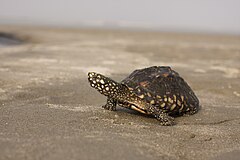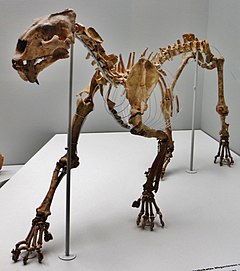| Pinjor Formation | |
|---|---|
| Stratigraphic range: Pleistocene ~2.28–1.6 Ma PreꞒ Ꞓ O S D C P T J K Pg N ↓ Pleistocene | |
| Type | Geological formation |
| Underlies | Tatrot Formation |
| Location | |
| Coordinates | 30°42′N 76°48′E / 30.7°N 76.8°E / 30.7; 76.8 |
| Approximate paleocoordinates | 29°12′N 77°18′E / 29.2°N 77.3°E / 29.2; 77.3 |
| Region | Hariyana, Punjab India, Himachal Pradesh, Punjab Pakistan, Chandigarh |
| Country | |
 | |
The Pinjor Formation is a Cenozoic geologic formation in India. The fossils of large crocodilians and mammals have been recovered from the formation.
Paleobiota
Reptiles
| Reptiles from the Pinjor Formation | |||||
|---|---|---|---|---|---|
| Genus | Species | Material | Location | Notes | Images |
| Rhamphosuchus | R. crassidens | piece of rostrum, middle portion of craniurns, hind portion of mandibular symphysis, quadrate and quadratojugal, partial mandibular symphysis, several vertebrae, left ilium, small left ilium, right fibula, and several scute. | Chandigarh | A large gharial |  |
| Gavialis | G. browni | Chandigarh | Gharials |  | |
| G. gangeticus | |||||
| G. sp. | |||||
| Crocodylus | C. palustris | Chandigarh | Mugger crocodiles |  | |
| C. biporcatus | |||||
| C. palaeoindicus | |||||
| Varanus | V. sivalensis | Distal end of right humerus and dorsal vertebrae | Chandigarh | A large monitor lizard similar to the Komodo dragon |  |
| Omegachelys | O. sahnii | Uttar Pradesh, | An emydid turtle | ||
| Geoclemys | G. hamiltonii | Uttar Pradesh | A geoemydid turtle |  | |
| Hardella | H. thurjii | Uttar Pradesh | A geoemydidae turtle |  | |
| Megalochelys | sp. | Chandigarh | A tortoise |  | |
Mammals
Crustaceans
| Crustaceans from the Pinjor Formation | |||||
|---|---|---|---|---|---|
| Genus | Species | Material | Location | Notes | Images |
| Potamon | sp. | Chandigarh | A crab | ||
References
- V. Kumaravel, S. J. Sangode; Rohtash Kumar, N. Siva Siddaiah (2005). "Magnetic polarity stratigraphy of Plio–Pleistocene Pinjor Formation (type locality), Siwalik Group, NW Himalaya, India". Zoological Journal of the Linnean Society. doi:10.1093/zoolinnean/zlad184.
- Martin, J. E. (2018). "The taxonomic content of the genus Gavialis from the Siwalik Hills of India and Pakistan" (PDF). Papers in Palaeontology. 5 (3): 483–497. doi:10.1002/spp2.1247.
- Hocknull, Scott; Piper, Philip; Van den Bergh, Gert; Due, Rokus; Morwood, Michael; Kurniawan, Iwan (2009). "Dragon's Paradise Lost: Palaeobiogeography, Evolution and Extinction of the Largest-Ever Terrestrial Lizards (Varanidae)". PLOS ONE. 4 (9): e7241. Bibcode:2009PLoSO...4.7241H. doi:10.1371/journal.pone.0007241. PMC 2748693. PMID 19789642.
- Falconer, Hugh (1868). Palæontological Memoirs and Notes of the Late Hugh Falconer: Fauna antiqua sivalensis. R. Hardwicke. p. 231.



